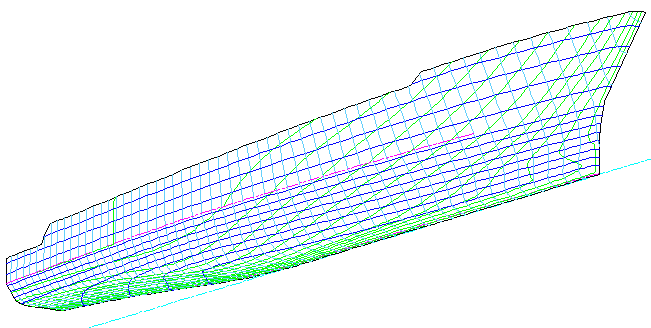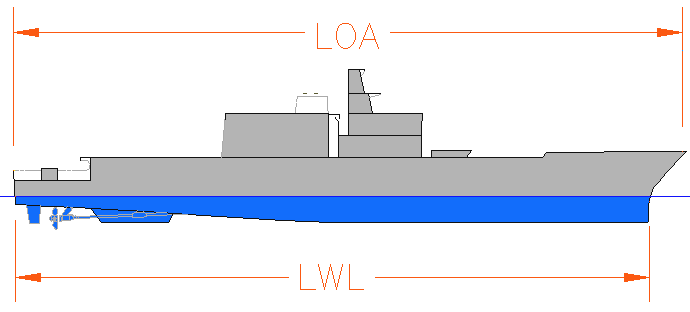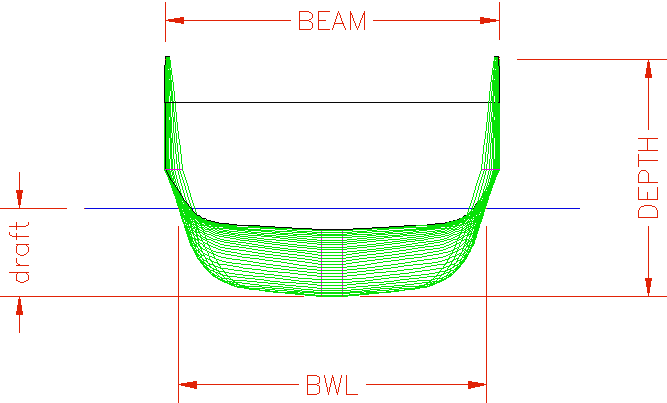|
A
hull is the body of a ship
or boat. It
is a central concept in floating vessels as it provides the buoyancy
that keeps the vessel from sinking.

"Hull
Form"
General
features
Nearly
all watercraft, from small boats to the largest ships, adhere to a
general form that serve the needs of stability and efficient propulsion,
featuring:
-
horizontal
cross-sections that have narrow, usually pointed, fronts (at the
bow),
-
smooth
widening from the bow until roughly the middle of the length (midships),
and often narrowing smoothly but usually significantly to the
extreme end (the stern), whose width may range from a large to an
insignificant fraction of the beam width.
Hull
shape
Hulls
come in many varieties but are grouped primarily as follows:
-
-
-
defined
as smooth curves
-
-
have
at least one pronounced knuckle throughout all or most of
their length
After
this they can be categorized as:
-
-
-
the
hull is supported exclusively or predominantly by the
pressure of water displaced by the hull
-
-
the
hull form is capable of developing a moderate amount of
dynamic lift, however, most of the vessel's weight is still
supported through displacement
-
-
the
Planing Hull form is configured to develop positive dynamic
pressure so that its draft decreases with increasing speed.
The
inverted bell shape of the hull, with smaller payload the waterline
cross-section is less, hence the resisitance is less and the speed is
higher. With higher payload the outward bend provides smoother
performance in waves.
Many
hulls have composite shape, e.g., a fine entry forward and inverted bell
shape aft.
Appendages
-
-
-
Terms
Bow
is the frontmost part of the hull
Stern
is the rear-most part of the hull
Portside
is the left side of the boat when facing the Bow
Starboard
is the right side of the boat when facing the Bow
Waterline
is an imaginary line circumscribing the hull that matches the surface of
the water when the hull is not moving.
Midships
is the midpoint of the LWL (see below). It is half-way from the
forwardmost point on the waterline to the rear-most point on the
waterline.
Baseline
an imaginary reference line used to measure vertical distances from. It
is usually located at the bottom of the hull.

"LWL
& LOA"
Metrics
Hull
forms are defined as follows:
-
-
-
Length
Overall (LOA) is the extreme length from one end to
the other
-
Length
on the Waterline (LWL) is the length from the
forwardmost point of the waterline measured in profile to
the stern-most point of the waterline.
-
Length
Between Perpendiculars (LBP or LPP) is the
length of the summer load waterline from the stern post to
the point where it crosses the stem.
-
Beam
or breadth (B) is the width of the hull. (ex: BWL is
the maximum beam at the waterline)
-
Depth
(D) is the vertical distance from the bottom of the
hull to the uppermost edge at the side.
-
Draft
(d) or (T) is the vertical distance from the
bottom of the hull to the waterline.
-
Freeboard
(FB) is the difference between Depth and draft.

"Beam,
draft & Depth
-
-
-
Volume
(V or ∇) is the volume of water
displaced by the hull.
-
Displacement
(Δ) is the weight of water equivalent to the
immersed volume of the hull.
-
Longitudinal
Centre of Buoyancy (LCB) is the longitudinal distance
from a point of reference (often Midships) to the centre of
the displaced volume of water when the hull is not moving.
Note that the Longitudinal Centre of Gravity or centre of
the weight of the vessel must align with the LCB when the
hull is in equilibrium.
-
Vertical
Centre of Buoyancy (VCB) is the vertical distance
from a point of reference (often the Baseline) to the centre
of the displaced volume of water when the hull is not
moving.
-
Longitudinal
Centre of Floatation (LCF) is the longitudinal
distance from a point of reference (often Midships) to the
centre of the area of waterplane when the hull is not
moving. This can be visualized as being the area defined by
the water's surface and the hull.
-
-
-
-
-
1)
Block Coefficient (Cb) is the volume (V)
divided by the LWL x BWL x T. If you draw a box around the
submerged part of the ship, it is the ratio of the box
volume occupied by the ship. It gives a sense of how much of
the block defined by the Lwl, Bwl
& draft (T) is filled by the hull. Full forms such as
oil tankers will have a high Cb where fine shapes
such as sailboats will have a low Cb.
-
-
-
-
-
-
-
2)
Midship Coefficient (Cm or Cx)
is the Bwl x draft divided by the cross-sectional
area (Ax) of the slice at Midships (or at the
largest section for Cx). It displays the ratio of
the largest underwater section of the hull to a rectangle of
the same overall width and depth as the underwater section
of the hull. This defines the fullness of the underbody. A
low Cm indicates a cut-away mid-section and a high Cm
indicates a boxy section shape. Sailboats have a cut-away
mid-section with low Cx whereas cargo vessels
have a boxy section with high Cx to help increase
the Cb.
-
-
-
-
-
-
-
3)
Prismatic Coefficient (Cp) is the volume
(V) divided by Lwl x Ax. It displays
the ratio of the underwater volume of the hull to a
rectangular block of the same overall length as the
underbody and with cross-sectional area equal to the largest
underwater section of the hull. This is used to evaluate the
distribution of the volume of the underbody. A low Cp
indicates a full mid-section and fine ends, a high Cp
indicates a boat with fuller ends. Planing hulls and other
highspeed hulls tend towards a higher Cp.
Efficient displacement hulls travelling at a low Froude
number will tend to have a low Cp.
-
-
-
-
-
-
-
4)
Waterplane Coefficient (Cw) is the
waterplane area divided by Lwl x Bwl.
The waterplane coefficient expresses the fullness of the
waterplane, or the ratio of the waterplane area to a
rectangle of the same length and width. A low Cw figure
indicates fine ends and a high Cw figure indicates fuller
ends. High Cw improves stability as well as handling
behavior in rough conditions.
-
-
-
-
-
Note:
Cb = Cp - Cm
History
Rafts
have a hull of sorts, however, hulls of the earliest design are thought
to have each consisted of a hollowed out tree
bole: in effect the first canoes.
Hull form then proceeded to the Coracle shape and on to more
sophisticated forms as the science of Naval architecture advanced.
See
also
LINKS
and REFERENCE

Healthier
alternative tastes for adventure capitalists

Solar
Red | Solar
Cola | Solar
Crush | Solar
Citrus | Solar
Spice
|



